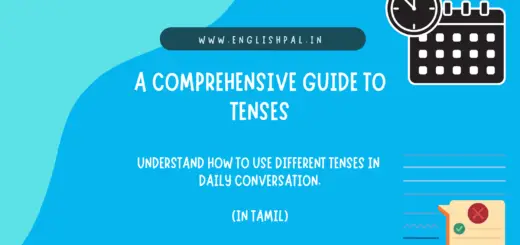Imperative sentences direct to indirect speech in Tamil
Imperative sentence – கட்டளை வாக்கியம்
Imperative sentence ஐ நாம் தமிழில் கட்டளை வாக்கியம் என அழைக்கப்படுகிறது. நாம் ஒருவருக்கு கட்டளைகளை இட, நமது கோரிக்கைகளை அளிக்க, அறிவுறுத்தல்களை(instructions) அறிவிக்க இந்த கட்டளை வாக்கியமானது உதவுகிறது.
ஒரு வாக்கியமானது main verb இல் தொடங்கி, முற்றுப்புள்ளியுடன் முடிவதைக்கொண்டு நாம் imperative வாக்கியம் என கண்டறியலாம்.
மேலும், கட்டளை வாக்கியத்தில் subject வராது.
Example – Please close the door.
இங்கு வாக்கியமானது subject ஐ கொண்டு தொடங்காமல், main verb இல் தொடங்கி முற்றுப்புள்ளியுடன் முடிகிறது. எனவே இது imperative sentence ஆகும்.

Imperative sentence னை Direct speech ஐ Indirect speech ஆக மாற்ற
Imperative sentence னை Direct speech ஐ Indirect speech ஆக மாற்ற என்னென்ன செய்யவேண்டும் என்பதை காண்போம்.
Step 1
- முதலில் எவ்வகை வாக்கியம் என கண்டறிந்து அதன் reporting verb ஐ மாற்ற வேண்டும்.
- Says / says to – Commands / requests / Orders / Instructs / advices
- Said / said to – Commanded / requested / Ordered / Instructed / advised
- இடத்தை, சொல்லும் விதத்தைப் பொறுத்து Commands, requests, Orders, Instructs, advices என மாற்ற வேண்டும்.
Step 2
- quotation mark மற்றும் comma வை நீக்கி அதற்குபதில் conjunction ஐ உபயோகிக்க வேண்டும். (conjunctions பற்றி தெளிவாக அறிய Conjunctions (இணைப்புச் சொற்கள்) with Examples in Tamil)
- Main verb இல் வாக்கியமானது தொடங்கும் போது to ஐ உபயோகிக்க வேண்டும்.
- Main verb இல் வாக்கியமானது Negative form (எதிர்மறையாக) இல் தொடங்கும் போது not to ஐ உபயோகிக்க வேண்டும்.
Step 3
- யார் யாருடன் பேசுகிறார் என்பதை தெளிவாக புரிந்து அதனை அதாவது noun அல்லது pronoun ஐ மாற்ற வேண்டும். (Pronouns பற்றி தெரிந்து கொள்ள Pronoun (பிரதிப் பெயர்ச்சொல்) & it types in Tamil with examples)
Step 4
- இங்கு இந்த வகை வாக்கியத்தில் நாம் எந்த tense ஐயும் மாற்றத் தேவை இல்லை. (Tense பற்றியும் அதன் வகைகள் பற்றியும் அறிய All 12 Tenses in Tamil with examples)
step 5
- பின்பு சரியான பொருள் தரக்கூடிய adveribal ஐ மாற்ற வேண்டும்.
மேலே கூறிய steps ஆனது வரும் வாக்கியத்தைப் பொறுத்து மாறும். எல்லா வாக்கியங்களிலும் எல்லா steps உம் உபயோகிக்க முடியாது. சில இடங்களில் adverbial வராமல் இருக்கலாம் அல்லது மற்ற வேறு ஏதேனும் வராமலும் இருக்கலாம்.
Examples
மேலே நாம் கூறிய ஒவ்வொரு steps ஐ கொண்டு நாம் எப்படி ஒரு கட்டளை வாக்கியத்தை நேர்கூற்று வாக்கியத்தில் இருந்து அயற்கூற்று வாக்கியமாக எளிமையாக மாற்றுவது என 13 வெவ்வேறு எடுத்துக்கட்டுகளைக் கொண்டு தெளிவாக காணலாம்.
Example 1
Direct speech – Raja said to Rani, “Please open the window.”
Step 1
- வாக்கியமானது main verb இல் தொடங்கி முற்றுப்புள்ளியில் முடிந்துள்ளது. எனவே இது imperative sentence. அதற்க்கு தகுந்தவாறு reporting verb ஐ மாற்ற வேண்டும்.
- இங்கு please என வந்துள்ளது. எனவே இங்கு அவர் வேண்டுகோள் விடுக்கிறார். எனவே requested ஐ உபயோகிக்கலாம். – Raja requested Rani
Step 2
Quotation mark மற்றும் comma வை நீக்கி அதற்குபதில் to ஐ உபயோகிக்கவும். – Raja requested Rani to
Step 3
இங்கு நாம் tense ஐ மாற்ற வேண்டியது இல்லை. மேலும் இந்த வாக்கியத்தில் எந்த adverbial உம் வரவில்லை. எனவே அதையும் நாம் தவிர்த்து விடலாம். – Raja requested Rani to open the window.
Indirect speech – Raja requested Rani to open the window.
Example 2
Direct speech – He said, “Pass me the salt, please.”
Step 1
- இந்த வாக்கியமும் main verb இல் தொடங்கி உள்ளது. மேலும் இந்த வாக்கியத்திலும் please வந்துள்ளது. எனவே reporting verb ஆனது requested என வரும். – He requested
Step 2
- இங்கு நாம் to என்ற conjunction ஐ உபயோகிக்க வேண்டும். – He requested to
- requested என குறிபிட்டுள்ளதால் நாம் please ஐ உபயோகிக்கத் தேவையில்லை.
Step 3
- இங்கு எந்த tense ஐயும் மாற்ற வேண்டியது இல்லை. – He requested to pass
Step 4
- me என்னும் pronoun ஆனது him என மாறும். மேலும் adverbial வராததால், அதனை தவிர்த்துக் கொள்ளலாம். – He requested to pass him the salt.
Indirect speech – He requested to pass him the salt.
Example 3
Direct speech – Manager said to the co-worker, “Complete the task before the deadline.”
- இது imperative sentence எனவே said to என்ற reporting verb ஆனது ordered என சூழ்நிலை மற்றும் பேசுபவரை பொருத்து மாறுகிறது. – Manager ordered the co-worker
- quotation mark மற்றும் comma வை நீக்கிவிட்டு, to என்னும் conjunction ஐ உபயோகிக்க வேண்டும். – Manager ordered the co-worker to
- இங்கு நாம் tense ஐ மாற்ற வேண்டியது இல்லை. அதனை அப்படியே வைத்துக்கொள்ளலாம். – Manager ordered the co-worker to complete the task before the deadline.
Indirect speech – Manager ordered the co-worker to complete the task before the deadline.
Example 4
Direct speech – Police officer said to me, “Wear a helmet to protect your life.”
- இங்கு போலீஸ் என்னிடம் கூறுவதாக வாக்கியம் அமைந்து உள்ளது. தலை கவசம் அணிந்து வாழ்கையை பாதுக்கத்துக்கொள் என அறிவுரை கூறுகிறார். எனவே இங்கு said to என்பது adviced என மாறும். – Police officer advised me
- கட்டளை வாக்கியம் என்பதால் to என்னும் conjunction ஐ உபயோகிக்க வேண்டும். – Police officer advised me to
- இங்கு நாம் tense ஐ மாற்ற வேண்டியது இல்லை. – Police officer advised me to wear a helmet to protect
- your என்னும் pronoun ஆனது my என மாறும். Adverbial வாக்கியத்தில் வரவில்லை.
Indirect speech – Police officer advised me to wear a helmet to protect my life.
Example 5
Direct speech – Mother said to her son, “Avoid bad habits.”
- அம்மா தன மகனிடம் கூறுவதாய் அமைந்துள்ளது. தீய பழக்கத்தை தவிர் என கூறுகிறார். எனவே இங்கு said to என்பது adviced என மாற்றுகிறோம். – Mother advised her son
- to என்னும் conjunction ஐ உபயோகப்படுத்துகிறோம்.- Mother advised her son to
- tense ஐ மாற்ற வேண்டியது இல்லை. மேலும் adverbial, pronoun போன்றவை வாக்கியத்தில் வரவில்லை. எனவே மீதம் உள்ளதை அப்படியே எழுதிக்கொள்ளலாம். – The mother advised her son to avoid bad habits.
Indirect speech – Mother advised her son to avoid bad habits.
Example 6
Direct speech – Haran said to Hari, “Do not follow my path.”
- இந்த வாக்கியத்தில் ஹரன், ஹரியிடம் தன் வழியை தொடராதே என கட்டளை இடுகிறான். எனவே இங்கு said to என்பது ordered என மாறும். – Haran ordered Hari
- இங்கு எதிர் மறையான வாக்கியம் வந்துள்ளது. எனவே not to என்ற conjunction ஐ உபயோகிக்க வேண்டும். – Haran ordered Hari not to
- tense ஐ மாற்ற வேண்டியது இல்லை. – Haran ordered Hari not to follow
- இங்கு my என்பது his என மாறும். – Haran ordered Hari not to follow his
Indirect speech – Haran ordered Hari not to follow his path.
Example 7
Direct speech – he said, “get out from here.”
- அவன் இங்கிருந்து போ என கோவமாக கூறுவதாக இந்த வாக்கியம் அமைந்துள்ளது. எனவே said என்பது shouted என மாறும். – he shouted
- Quotation mark, comma போன்றவற்றை நீக்க வேண்டும். to என்ற conjunction ஐ உபயோகிக்க வேண்டும். – he shouted to
- here என்ற adverbial ஆனது there என மாறும். இங்கு நாம் tense ஆற்ற வேண்டியது இல்லை.
Indirect speech – he shouted to get out of there.
Direct & Indirect Speech மற்றும் அதன் வகைகளை தெரிந்து கொள்ள
Direct speech and Indirect speech in Tamil
Interrogative sentences – Direct speech & indirect speech in Tamil
Statement sentences – Direct to indirect speech with examples in Tamil
Example 8
Direct speech – He said, “Do not forget to bring your wallet.”
- உன்னுடைய பணப்பையை மறக்காமல் கொண்டு வருமாறு அவன் கூறுவதாக வாக்கியம் உள்ளது. இங்கு பணப்பையை கொண்டு வர நினைவூட்டுகிறான். எனவே இங்கு said என்னும் reporting verb ஆனது remained என மாறும். – He remained
- இங்கு do not என்னும் எதிர்மறை வந்துள்ளது. அதனை to not என்னும் conjunction ஐக் கொண்டு மாற்ற வேண்டும். – He remained to not
- imperative sentenceஇல் நாம் tense ஐ மாற்ற வேண்டியது இல்லை. எனவே அதே verb ஐ உபயோகித்துக்கொள்ளலாம்.- He remained to not forget to bring
- your என்னும் pronoun ஆனது my என மாறும்.
Indirect speech – He remained to not forget to bring my wallet.
Example 9
Direct speech – Worker said, “Keep quiet during the work.”
- வேலை செய்யும்போது அமைதியாக இருக்குமாறு வேலையாள் கூறுவதாய் அமைந்துள்ளது. இதில் அமைதியாய் இருக்குமாறு அவர் வேண்டிக் கேட்கிறார். எனவே said என்னும் reporting verb ஆனது requested என மாறும். – worker requested
- to என்னும் conjunction ஐ உபயோகிக்க வேண்டும். – worker requested to
- இங்கு tense ஐ மாற்ற வேண்டிய அவசியம் இல்லை. எனவே அதனை அப்படியே வைத்துக்கொள்ளலாம்.
- மேலும் இந்த வாக்கியத்தில் எந்த ஒரு pronoun மற்றும் adverbial வரவில்லை. எனவே நாம் அந்த வாக்கியத்தை அப்படியே எழுதிக்கொள்ளலாம். – worker requested to keep quiet during the work.
Indirect speech – worker requested to keep quiet during the work.
Example 10
Direct speech – She said, “turn left and go straight.”
- இடது பக்கம் திரும்பி நேராக செல்லுமாறு அவள் கூறுவதாக இந்த வாக்கியம் அமைந்துள்ளது. இங்கு அவள் ஒரு குறிப்பிட்ட இடத்திற்கு போக instructions தருகிறாள். எனவே இங்கு said என்னும் reporting verb ஆனது instructed என எழுதலாம். – she instructed me
- இந்த வாக்கியம் imperative sentence ஆனதால் to என்னும் conjunction ஐ உபயோகிப்பது அவசியம்.- she instructed me to
- imperative sentence க்கு tense ஐ மாற்ற வேண்டிய அவசியம் இல்லை என்பதால் அதனை அப்படியே எழுதிக்கொள்ளலாம். மேலும் இந்த வாக்கியத்தில் noun அல்லது pronoun மற்றும் adverbial போன்றவை வரவில்லை. எனவே மீதி உள்ள வாக்கியத்தினை அப்படியே எடுத்துக்கொள்ளலாம். – She instructed me to turn left and go straight.
Indirect speech – she instructed me to turn left and go straight.
உங்களுக்கான பயிற்சி
கீழே குறிப்பிடப்பட்டுள்ள 3 எடுத்துக்காட்டுக்களை மேலே விளக்கியுள்ளபடி கீழே comment இல் மாற்றுங்கள். நாங்களே நேர்கூற்று மற்றும் அயற்கூற்றுக்களை மாற்றி கொடுத்துள்ளோம். இவை எப்படி வந்தது என comment இல் தெரிவியுங்கள்.
Exercise 1
Direct speech – “Finish your task before the end of the day”, the manager said to us.
Indirect speech – The manager ordered us to finish the task before the end of the day.
Exercise 2
Direct speech – MD said to me, “Please be on time for the meeting.”
Indirect speech – MD requested me to be on time for the meeting.
Exercise 3
Direct speech – Mom said to her children, “Do not touch the fire.”
Indirect speech – Mom ordered her children to not touch the fire.
Conclusion
கட்டளை வாக்கியங்களை எப்படி நேர்கூற்று வாக்கியத்தில் இருந்து அயற்கூற்று வாக்கியமாக மாற்றினோம் என்பதை எடுத்துக்காட்டுகளுடன் தெளிவாகி விளக்கி இருக்கிறோம். இது உங்களுக்கு எப்படி எந்த ஒரு வாக்கியத்தை கொடுத்தாலும் அயற்கூற்றாக மாற்றுவது என்பதை பற்றி ஒரு தெளிவான புரிதலை தந்திருக்கும் என நம்புகிறோம்.
நாங்கள் கொடுத்துள்ள 3 exercise க்கான பதிலை comments இல் தெரிவிக்கவும். மேலும் இந்த பதிவு தொடர்பாக ஏதேனும் சந்தேகங்கள் இருப்பினும் அத்தனையும் comment இல் தெரிவிக்கவும்.
மற்ற வகை வாக்கியங்களை எப்படி direct speech இல் இருந்து indirect speech ஆக மாற்றுவது எப்படி என அடுத்தடுத்த பதிவுகளில் காண்போம்.
நன்றி!



